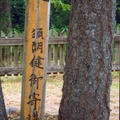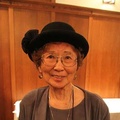When Japanese Canadians were forced from their homes on the British Columbia coast and interned in the interior mining town of Kaslo in 1942, one of them was already living there.
Although Koto Kennedy is not totally forgotten, little has been written about her, and what we do know about her is shrouded in mystery and speculation.
We don’t even know her birth name for certain: it was most likely Koto Shimizu, but her first name is sometimes given as Kato, and her maiden name as Shaunan or Shinnizn, probably from a misreading of handwritten documents.
She was born in Yokohama on April 11, 1874 or 1875, and was said to be the daughter of a geisha. According to her brief obituary in The New Canadian, she married a Canadian sailor at age 15 and came to British Columbia with him. It didn’t reveal his name or say what happened to him.
It suggested she arrived in Kaslo in 1889, which is before the village existed. Even if that’s an error, she may have been one of the first women in the fledgling mining camp—leading me to wonder if she was a prostitute, as was the case for nearly all Japanese women in the region’s early years. Barbara Bavington of the Kootenay Lake Historical Society believes she was.
Koto doesn’t appear on the 1901 or 1911 Canadian census, but there were two Japanese prostitutes listed in Kaslo in 1911.
The earliest evidence we have of Koto in Kaslo comes upon her wedding to miner John Kennedy on February 22, 1921, an early and unusual interracial marriage. He was 49. She was 46. The ceremony was held at the home of W.R. Whittaker, with John Skillicorn and Margaret Whittaker serving as the witnesses.
While Koto had supposedly previously married a sailor, the registration indicated she was a spinster. She signed her name Koto Shimizu, but elsewhere on the form her surname was given as Shawnigan and her parents were identified as Ichiyeman and Kinu. The 1921 census found the newlyweds living on Front St. and indicated Koto came to Canada in 1882.
John died of throat cancer on June 30, 1937. He had been in Kaslo at least since 1901 when he first appeared on the voters list. In addition to his wife, he was survived by two sisters in Cape Breton where he was born.
Aya Higashi—the last surviving Japanese-Canadian in Kaslo until her passing last year—told Langham museum curator Ian Fraser that Mrs. Kennedy “was a comfort to the internees, and that her husband treated her very well. She was held in awe as a highly cultured gentlewoman by the young internees.”
Higashi told archivist Elizabeth Scarlett that her parents befriended Koto when they came to Kaslo in 1942 and that she was very shy. They understood she came to Canada on a fishing boat as a teenager. Tom Shoyama, editor of The New Canadian, also befriended her.
Koto Kennedy died on September 18, 1951 at Kaslo Victorian Hospital at age 77 and was buried in the local cemetery. Her pallbearers were Mayor George S. Baker, S. Shinmoto, J. MacPherson, J. Paterson, William Dunn, and Ben Sutherland. She left a 91-year-old brother in Japan and a nephew.
No photo of her is known to exist, and her grave is no longer marked, if it ever was.
In 2002, the Kootenay Lake Archives received a letter from Hiroshi Shimizu of Mississauga (no relation), who was born in Canada but lived in Japan from the age of two and graduated from high school in Akita, a city in Japan’s northwest. Soon after he returned to the Toronto area where his mother and siblings lived.
Around 2000, one of his Akita classmates contacted him asking for any information on Koto Shimizu. The story he had heard in Japan was different and considerably more dramatic than the one contained in her obituary. As Scarlett related it to me, in 1889, Koto and her father were fishing off the coast of Akita when a violent storm buffeted their boat and they were carried by the storm through a narrow channel between the mainland and Hokkaido into the Pacific Ocean.
They drifted and eventually reached the coast of BC, where they were rescued by a man named Benjamin Kennedy, whose family she lived with, and later married his son John. (What happened to her father isn’t recorded.)
Koto returned to Japan in 1925, where she had been presumed dead, and was mobbed by reporters who covered her miraculous homecoming. The story was apparently widely reported in Japan, which is how Hiroshi’s friend came across it many years later. The news reports did not, however, indicate where Koto and her father were rescued in BC.
The friend was trying to find records of the initial search and rescue attempt in 1889, but hadn’t located anything by the last time Scarlett corresponded with Hiroshi, who has since died.
There are a couple of problems with this story: John Kennedy’s father was named Lachlin, not Benjamin. And despite the supposedly widespread coverage Koto’s return to Japan received, relentless searching on numerous digitized newspapers sites has so far failed to turn up anything.
There’s more to this story, but for the moment that’s as much as we know.
* This article was originally published in the Nelson Star on May 18, 2015, and has been slightly modified from the original by the author.
© 2015 Nelson Star / Greg Nesteroff




